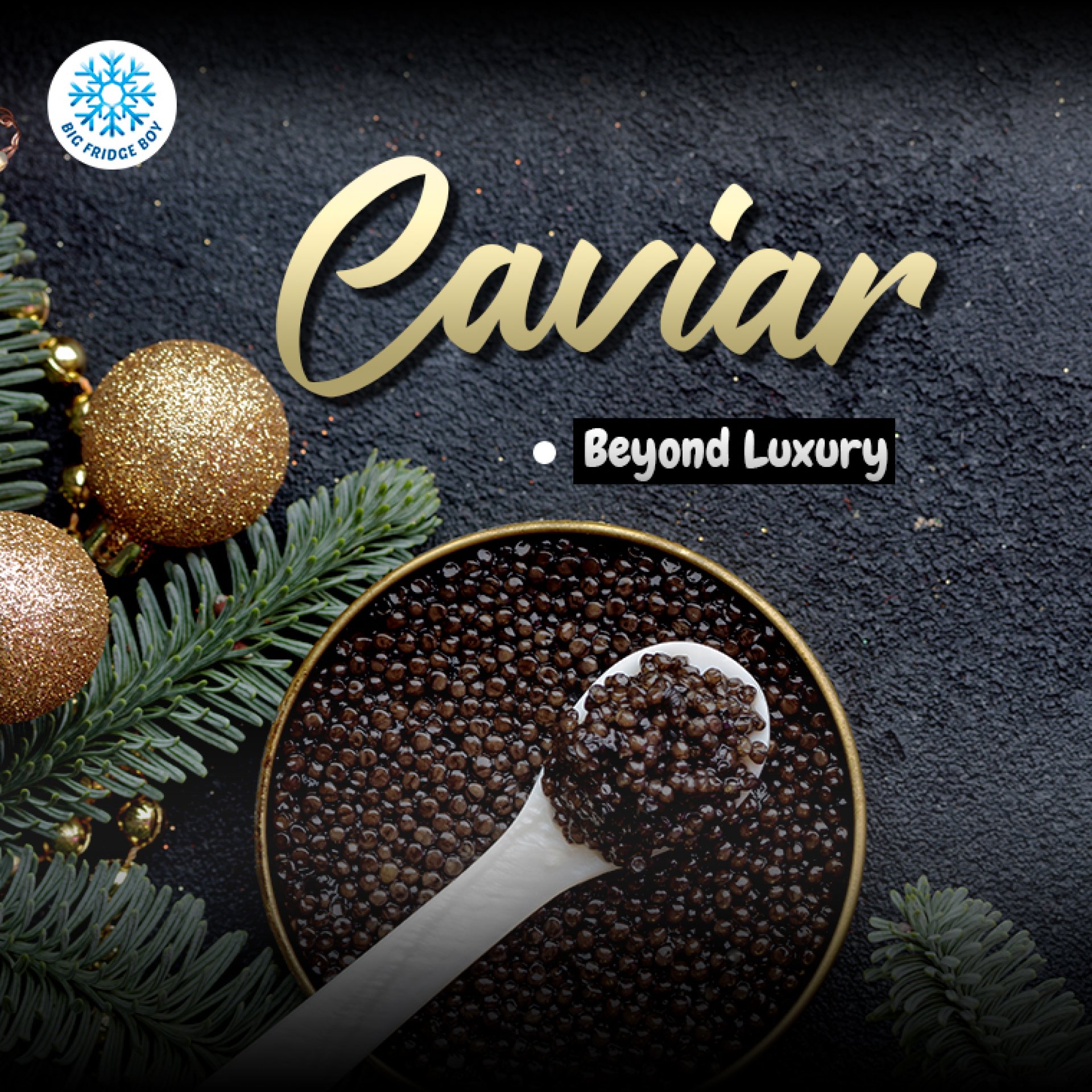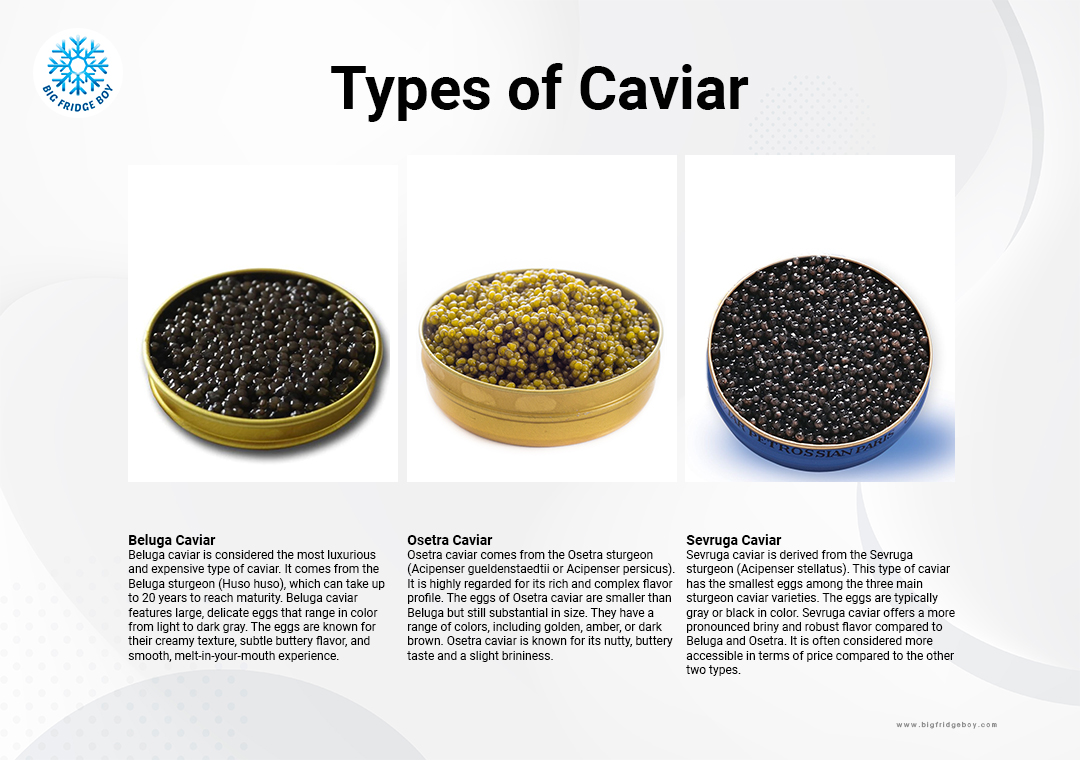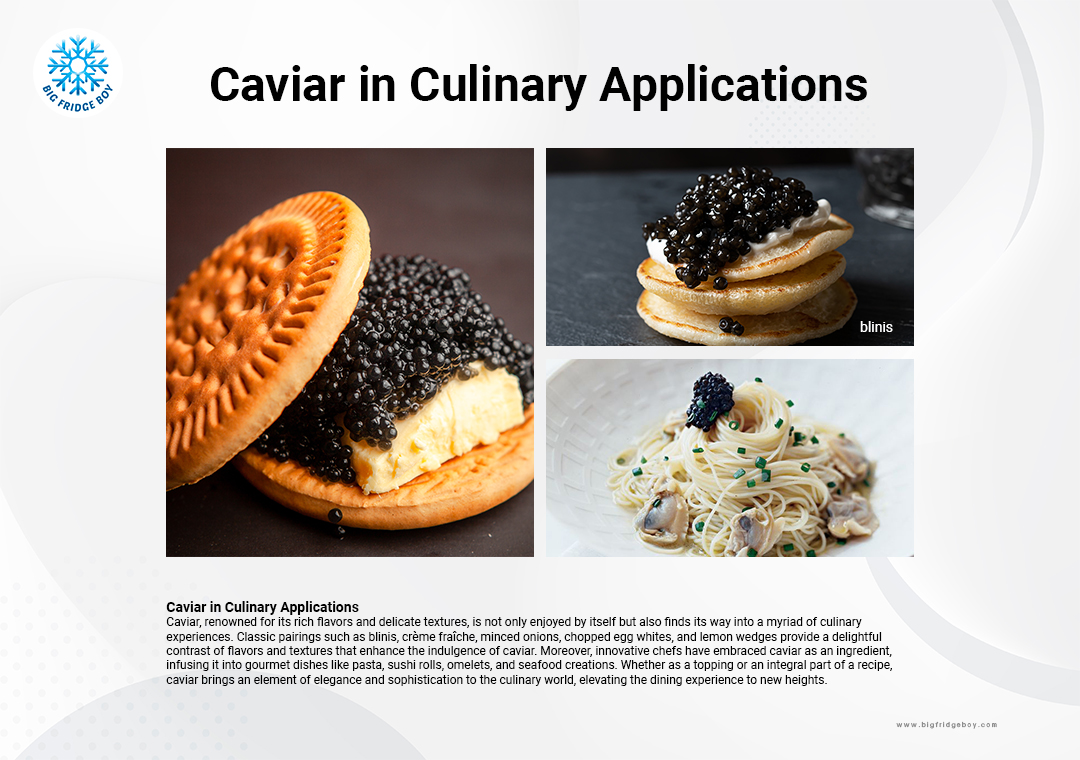"Beyond the Black Pearls: A Fascinating Dive into Caviar"

Caviar has a long history and has been enjoyed for centuries. It was highly valued in ancient Persia (modern-day Iran) and was served to royalty and nobility. Caviar became popularized in Europe during the 18th and 19th centuries, particularly in Russia, where it became synonymous with luxury and decadence. Today, caviar continues to be associated with elegance and prestige in culinary circles worldwide.

Types of Caviar
The most well-known types of caviar come from sturgeon, including Beluga, Osetra, and Sevruga.
- Beluga Caviar
Beluga caviar is considered the most luxurious and expensive type of caviar. It comes from the Beluga sturgeon (Huso huso), which can take up to 20 years to reach maturity. Beluga caviar features large, delicate eggs that range in color from light to dark gray. The eggs are known for their creamy texture, subtle buttery flavor, and smooth, melt-in-your-mouth experience. - Osetra Caviar
Osetra caviar comes from the Osetra sturgeon (Acipenser gueldenstaedtii or Acipenser persicus). It is highly regarded for its rich and complex flavor profile. The eggs of Osetra caviar are smaller than Beluga but still substantial in size. They have a range of colors, including golden, amber, or dark brown. Osetra caviar is known for its nutty, buttery taste and a slight brininess. - Sevruga Caviar
Sevruga caviar is derived from the Sevruga sturgeon (Acipenser stellatus). This type of caviar has the smallest eggs among the three main sturgeon caviar varieties. The eggs are typically gray or black in color. Sevruga caviar offers a more pronounced briny and robust flavor compared to Beluga and Osetra. It is often considered more accessible in terms of price compared to the other two types.
Other types of caviar include salmon, trout, and paddlefish caviar, which are more affordable alternatives.
Grading Caviar
When it comes to grading caviar, several factors are taken into consideration to assess its quality and value. While grading systems may vary, here are some common criteria used in the grading process:
- Size
The size of caviar eggs can vary, and larger eggs are generally considered more desirable. The size is often measured in millimeters, with larger eggs fetching higher prices. - Color
The color of caviar can range from light to dark, depending on the species and the specific processing methods. The color is evaluated for its uniformity and intensity. Generally, lighter-colored caviar is considered more valuable. - Texture
The texture of caviar is evaluated based on its firmness and consistency. High-quality caviar should have eggs that are firm, plump, and have a pleasing "pop" when consumed. - Flavor
The flavor profile of caviar is essential in determining its quality. It should have a well-rounded, distinct taste that is often described as buttery, nutty, or briny. The flavor should be balanced and free from any unpleasant or fishy aftertaste.
Grading systems can differ depending on the producer or country of origin. The grading process is typically done by experienced professionals who carefully inspect and assess the caviar based on these criteria.
Higher-grade caviar often commands higher prices due to its superior quality, while lower-grade caviar may still be of good quality but may have some variations in size, color, or flavor. Grading helps buyers understand and choose caviar based on their preferences and budget, ensuring they get the desired quality and experience.
Storing
Caviar is highly perishable and should be stored properly to maintain its quality. It is best kept in the coldest part of the refrigerator, ideally between 28-32°F (-2 to 0°C). Unopened caviar can usually be stored for a few weeks, while opened jars or tins should be consumed within a few days to a week.
Caviar Etiquette
Metal utensils should be avoided when serving caviar, as they can affect the flavor. Caviar is traditionally served with a special spoon made from a non-reactive material such as mother-of-pearl, horn, or wood. To serve, caviar is traditionally placed on a chilled serving dish nested in ice or served directly on ice to keep it cold. It is also recommended to avoid chewing the caviar vigorously; instead, let the eggs gently burst in your mouth, releasing their flavor.

Caviar in Culinary Applications
Caviar, renowned for its rich flavors and delicate textures, is not only enjoyed by itself but also finds its way into a myriad of culinary experiences. Classic pairings such as blinis, crème fraîche, minced onions, chopped egg whites, and lemon wedges provide a delightful contrast of flavors and textures that enhance the indulgence of caviar. Moreover, innovative chefs have embraced caviar as an ingredient, infusing it into gourmet dishes like pasta, sushi rolls, omelets, and seafood creations. Whether as a topping or an integral part of a recipe, caviar brings an element of elegance and sophistication to the culinary world, elevating the dining experience to new heights.
Caviar and Health Benefits
Caviar is known for being a good source of omega-3 fatty acids, which are beneficial for heart health, brain function, and inflammation reduction. It is also rich in vitamins and minerals, including vitamin B12, vitamin A, iron, and selenium. However, it's important to consume caviar in moderation due to its high sodium content.
Caviar, with its distinct flavors, luxurious textures, and esteemed reputation, holds a special place in the culinary world. From the prized Beluga, Osetra, and Sevruga sturgeon caviar to more accessible alternatives like salmon, trout, and paddlefish caviar, there is a wide range of options to suit different palates and budgets.





